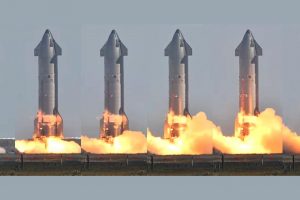SpaceX has successfully ignited all six engines on its latest Starship prototype, taking a significant step towards ensuring that the upper stage will be ready for the rocket’s first orbital launch attempt.
Unfortunately, the same successful static fire of a Starship upper stage – potentially producing almost twice as much thrust as the booster of SpaceX’s Falcon 9 rocket – scattered superheated debris hundreds of meters away, igniting a major brush fire. It’s not the first major fire caused by Starship activities in South Texas, and it likely won’t be the last.
Starship S24 completed its first successful static fire on August 9th, igniting two Raptor engines. Several unsuccessful attempts to test more engines followed throughout the rest of the month, and SpaceX ultimately decided to replace one of Starship S24’s three Raptor Vacuum engines in early September before trying again. After workers installed the new engine and buttoned up Ship 24, the stars eventually aligned on September 8th.
Kicking off the test, SpaceX pumped several hundred tons of liquid oxygen (LOx) and a much smaller quantity of liquid methane (LCH4) fuel into Ship 24 in about 90 minutes, producing a crisp layer of frost wherever the cryogenic liquids touched the skin of the rocket’s uninsulated steel tanks. No frost formed on Starship’s upper methane tank, implying that SpaceX only loaded methane fuel into internal ‘header’ tanks meant to store propellant for landings. The hundreds of tons of liquid oxygen, then, were likely meant as ballast, reducing the maximum stress Starship could exert on the test stand holding it to the ground.
That potential stress is substantial. Outfitted with upgraded Raptor 2 engines, Starship S24 could have produced up to 1380 tons (~3M lbf) thrust when it ignited all six for the first time at 4:30 pm CDT. On top of smashing the record for most thrust produced during a Starbase rocket test, Ship 24’s engines burned for almost 8 seconds, making it one of the longest static fires ever performed on a Starship test stand.
Several brush fires were visible almost immediately after clouds of dust and steam cleared. More likely than not, the combination of the extreme force, heat, and burn duration likely obliterated the almost entirely unprotected concrete surface below Ship 24. Despite continuous evidence that all Starship static fire operations would be easier and safer with the systems, SpaceX still refuses to install serious water deluge or flame deflector systems at Starbase’s test stands and launch pads.
Instead, under its steel Starship test stands, SpaceX relies on a single middling deluge spray nozzle and high-temperature concrete (likely martyte) that probably wouldn’t pass muster for a rocket ten times less powerful than Starship. In multiple instances, Starships have shattered that feeble martyte layer, creating high-velocity ceramic shards that damage their undersides or Raptor engines, requiring repairs and creating risky situations. With essentially no attempt at all to tame the high-speed several-thousand-degree Raptor exhaust, static fire tests at Starbase thus almost always start small grass fires and cause minor damage, but those fires rarely spread.

Ship 24’s first six-engine test was not so lucky, although the Starship made it through seemingly unscathed. Most likely, eight long seconds of blast-furnace conditions melted the top layer of surrounding concrete and shot a hailstorm of tiny superheated globules in almost every direction. Indeed, in almost every direction there was something readily able to burn, a fire started. In several locations to the south and west, brush caught fire and began to burn unusually aggressively, quickly growing into walls of flames that sped across the terrain. To the east, debris even made it into a SpaceX dumpster, the contents of which easily caught fire and burned for hours.
Eventually, around 9pm CDT, firefighters were able to approach the safed launch pad and rocket, but the main fire had already spread south, out of reach. Instead, they started controlled burns near SpaceX’s roadblock, hoping to clear brush and prevent the fire (however unlikely) from proceeding towards SpaceX’s Starbase factory and Boca Chica Village homes and residents.
The nature of the estuary-like terrain and wetlands means that it’s very easy to stop fires at choke points, so the fire likely never posed any real threat to Boca Chica residents, SpaceX employees, or onlookers. It was also unlikely to damage SpaceX’s launch facilities or return to damage Starship S24 from the start, as both of are surrounded by a combination of concrete aprons, empty dirt fields, and a highway.
Still, the “brush” burned by the fire is a protected habitat located in a State Park and Wildlife Refuge. While fire is a natural and often necessary element of many habitats, including some of those in Boca Chica, this is the second major brush fire caused by Starship testing since 2019, which may be less than desirable. At a minimum, fighting fires around Starbase generally requires firefighters to walk or even drive on protected wetlands and salt flats, the impact of which could ultimately be as bad for wildlife and habitats as the fire itself.
SpaceX’s Federal Aviation Administration (FAA) Programmatic Environmental Assessment (PEA), which fully greenlit the company’s existing Starbase Texas facilities and launch plans earlier this year, only discusses fire [PDF] a handful of times. Repairing and preventing future damage to wetlands, however, comes up dozens of times and is the subject of numerous conditions SpaceX must meet before the FAA will grant Starship an orbital launch license.
Ultimately, given that the FAA approved that PEA in full awareness of a 2019 brush fire caused by Starhopper (an early Starship prototype) that may have been as bad or worse than 2022’s, there’s a chance that it will play a small role in the ongoing launch licensing process, but the odds of it being a showstopper are close to zero. Still, it would likely benefit SpaceX at least as much as the surrounding Boca Chica wilderness if it can implement changes that prevent major brush fires from becoming a regular ‘accidental’ occurrence.





